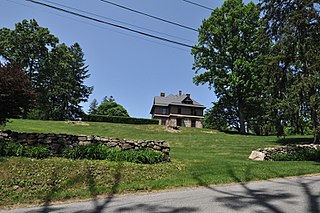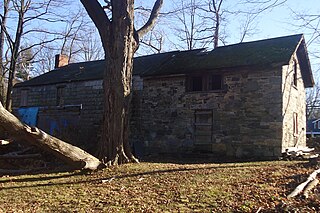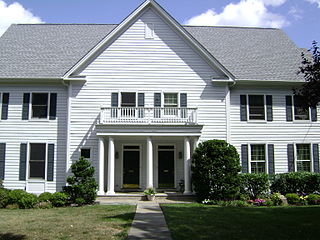
Bronxville is a village in Westchester County, New York, United States, located approximately 15 miles (24 km) north of Midtown Manhattan. It is part of the town of Eastchester. The village comprises one square mile (2.5 km2) of land in its entirety, approximately 20% of the town of Eastchester. As of the 2020 U.S. census, Bronxville had a population of 6,656. In 2016, Bronxville was rated by CNBC as the most expensive suburb of any of the U.S. ten largest cities, with a median home value of $2.33 million. It was ranked eighth in Bloomberg's "America's 100 Richest Places" in 2017 and 2018 and ninth in 2019 and is the second-richest town in the state of New York behind Scarsdale.

The United Methodist Church and Parsonage are a historic United Methodist church and its adjacent historic parsonage located on a 2-acre tract on the corner of East Main Street and Smith Avenue in Mount Kisco, Westchester County, New York. The New Castle Methodist Episcopal Church was designed by J. King in the Carpenter Gothic style of architecture and built in 1868 by Edward Dauchey, while the parsonage, designed in the Victorian style of architecture, was built in 1871. Today the church is known as the United Methodist Church of Mt. Kisco. On November 4, 1982, both the church building and the parsonage were listed on the National Register of Historic Places as a single filing.

The Davenport House, also known as Sans-Souci, is an 1859 residence in New Rochelle, New York, designed by architect Alexander Jackson Davis in the Gothic Revival style. The "architecturally significant cottage and its compatible architect-designed additions represent a rare assemblage of mid-19th through early 20th century American residential design". The house was listed on the National Register of Historic Places in 1980.

Stonecrest is a historic home located at Bedford Corners, Westchester County, New York. It was built in 1879 in an eclectic Stick-Eastlake style and renovated in 1916. It is a rectangular three-story dwelling, measuring 50 feet deep and 45 feet wide. The first story is built of random rubble and the second of wood shingles that flare away from the first floor. A slate covered hipped roof covers the third floor and attic. Also on the property are a contributing Stick Style carriage house, stone root cellar, and stone spring house.

The Odell House is a historic home located at Greenburgh, Westchester County, New York. The farm served as the headquarters of Count de Rochambeau and campsite for the French expeditionary forces under his command during the American Revolutionary War, from July 6 to August 18, 1781.

Romer-Van Tassel House is a historic home located at Greenburgh, Westchester County, New York. It was built in 1793 and is a 1+1⁄2-story, rectangular stone dwelling, topped by a gable roof. The coursed stone foundation may be the remains of an earlier dwelling and date to about 1684. The house was renovated in the 1920s and the 1+1⁄2-story wood-frame kitchen wing dates to that time. The house served as the first Greenburgh town hall from 1793 into the early 19th century.

Hadden-Margolis House is a historic home located at Harrison, Westchester County, New York. It was originally built about 1750 with later modifications in the 19th century in the Italianate style and early 20th century Colonial Revival style. It is a 2+1⁄2-story, center hall type dwelling covered in stucco over a heavy wood-frame structure. It has a stone foundation and straight pitched gable roof.

Albert E. and Emily Wilson House is a historic home located at Mamaroneck, Westchester County, New York. It was built between 1949 and 1951 and is a "U" shaped, one story Colonial Revival style red brick residence with a low-pitched, gray slate gable roof. The office wing was added in 1953. The entry features a Dutch door flanked by small, steel casement windows. It was designed by and the home of local architect Albert E. Wilson (1878-1955), who was a partner in the prominent firm of Peabody, Wilson, and Brown.

John Stevens House is a historic home located at Mount Vernon, Westchester County, New York. It was built between 1849 and 1851 and is a five-by-three-bay, 2+1⁄2-story, substantial frame farmhouse. It features a 1-story porch across the front elevation that incorporates six Doric order columns and a dentiled cornice. It was the home of John Stevens (1803–1882), founder of Mount Vernon.

Edgewood House is an historic school building located at Pelham Manor, Westchester County, New York. It was built in 1893 and is a 3+1⁄2-story, wood and masonry building in the Colonial Revival style. It is composed of a wide central gable roofed pavilion, flanked by flat-roofed wings of balanced proportions. It features deep porches and a large semi-elliptical bay window. It was once associated with Mrs. Hazen's School (1889-1915) and is representative of a turn-of-the-century academic building. The building once housed reception areas, classrooms, a gymnasium, dormitories, and staff quarters. It has been converted to apartments.

Pelhamdale, also known as The Old Stone House of Philip Pell II, is a historic home located in Pelham Manor, Westchester County, New York. It was built about 1750 as a single story dwelling and expanded after 1823. It is a two-story, five bay, stone residence faced in coursed, rock-faced stone ranging in color from muted orange and red, to gray. It has white native sandstone Doric order columns on the front porch, lintels and sills, and a plain brick entablature. It features two 2-story bay windows flanking the main entrance. Philip Pell II was a grandson of Thomas Pell (1608–1669).

The Caleb Hyatt House is a historic house located at 937 White Plains Post Road in Scarsdale, Westchester County, New York.

Wayside Cottage is a historic home located at Scarsdale, Westchester County, New York. The earliest part of the house was built about 1720 and is the four-bay-wide, two-bay-deep, 1+1⁄2-story south section. It sits on a fieldstone foundation and has a gable roof and verandah with Doric order piers. The center section of the house was built in 1828 and it is a 2+1⁄2-story, three-bay-wide structure with a gable roof and sheathed in clapboard. A third section is known as the "caretaker's quarters" and was built in the late 19th century. It is two stories high, three bays wide, and two bays deep. A wing was added to this section in 1928. The house underwent a major restoration in 1953–1954. Since 1919, it has been owned by the Junior League of Central Westchester. It was also where Scarsdale Public Library used to be.

Percy Grainger Home and Studio is a historic home located at White Plains, Westchester County, New York. It was built in 1893 and is a two-story, three-bay-wide dwelling with a pyramidal hipped roof in the American Foursquare style. It features a full-width, one-story porch supported by four Doric order columns. The main entrance is a Dutch door. It was the home of musician Percy Grainger from 1921 to his death in 1961.

Scarsdale Woman's Club is a historic women's club located at Scarsdale, Westchester County, New York. It was built in 1858 and expanded and remodeled in 1872 in the Second Empire style. It was again expanded and remodeled in 1941 by Hobart Upjohn. The former residence is a 1+1⁄2-story wood-frame building, clad in stucco, with a prominent mansard roof covered in red and blue hexagonal slate tiles. It features a five-bay open front porch supported by square and Doric order columns. It was acquired by the Scarsdale Women's' Club in 1928 for use as a clubhouse.

Bird Homestead, also known as the Bouton-Bird-Erikson Homestead, is a historic home and farm complex located in Rye, Westchester County, New York. It is owned by the city of Rye and was purchased in 2009. The property is situated on Blind Brook estuary, off the Long Island Sound. The property is adjacent to the Rye Meeting House. The main part of the house was built in 1835, and is a two-story, three-bay wide frame building in the Greek Revival style. It sits on a brick foundation and has a low-pitched, side gable roof. It features a one-story, full-width, front porch. Also on the property are a contributing two-story barn built in the 1880s and a long, one-story outbuilding.

Marmaduke Forster House, also known as the Forster-Hobby-Washburn House, is an historic home located in Pleasantville, Westchester County, New York. The original section of the house was built about 1785 by Marmaduke Forster, a colonial carpenter from New York City, as a 1+1⁄2-story, timber frame dwelling. It was remodeled and enlarged in the 19th century, first about 1840 in the Gothic Revival style and again in 1895 by architect George P. Washburn. This later modification added Queen Anne style elements - an octagonal turret on the front facade and a chateau wing with 20 colored glass panes. The house features a rambling 80-feet verandah with elaborate woodwork. The house was renovated in 2007, and a two-story addition built. Currently it houses small business offices.

Rye Meeting House, also known as Milton Mission Chapel, Grace Chapel, and the Friends Meeting House, is a historic Quaker meeting house located at Rye, Westchester County, New York. The property is adjacent to the Bird Homestead. It is a one-story, wood-frame building on a stone foundation with two main volumes, a nave and an asymmetrical transept. The exterior is sheathed in clapboard and shingles and exhibits characteristics of the Stick style. The front facade features a 2+1⁄2-story bell tower. The building was built in the 1830s as a school house. It was moved to its present site in 1867, and enlarged in 1871, 1875, and 1877. At the time, the church was a mission church of nearby Christ's Church, an Episcopal church. The Quakers obtained the property in 1959. The property was deeded to the city of Rye in 2002.

Presbyterian Rest for Convalescents, also known as the Y.W.C.A. of White Plains and Central Westchester, is a historic convalescent home located at White Plains, Westchester County, New York. It was built in 1913, and is a 3+1⁄2-story, "H"-shaped building in the Tudor Revival style. The two lower stories are in brick and the upper stories in half-timbering and stucco. It has a tiled gable roof with dormer windows. The section connecting the two wings includes the main entrance, which features stone facing and Tudor arches. The connected Acheson Wallace Hall was built in 1972. The building housed a convalescent home until 1967, after which it was acquired by the Y.W.C.A. and operated as a residence for women.

Leffingwell–Batcheller House is a historic home located at Yonkers, Westchester County, New York. It was designed by noted New York architect R. H. Robertson and built between about 1887 and 1889. It is a 2+1⁄2-story, masonry and frame dwelling in the Queen Anne style. It has a hipped roof with gabled dormers and sheathed in rough-hewn brownstone, pressed and common brick, wood shingle, and wood clapboard. It features a broad verandah, a two-story rounded bay, and a rounded bay with conical roof.
























